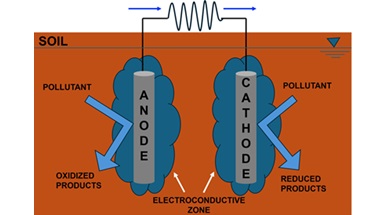
Electrochemistry combined with microbial life in the so called microbial bioelectrochemical systems can certainly being a power tool for degrading organics compounds in contaminated soils and transforming various pollutants into harmless compounds. In fact, the microbial degradation of pollutants can be enhanced when combined with electrochemical methods. The application of external potentials can certainly enhance the degradation shortening the operational time. While many experiments have been carried out in small scale at laboratory level, scaling up the system into large scale with square meters of electrodes, is quite challenging and complicated.
With particular attention to groundwater, one of the main bottlenecks of this technology is the scarce ionic and electronic conductivity of groundwater that lower the efficiency of electrochemical methods as well as the microbial activity combined with electrochemical methods.
The review consists of many topics that included microbial bioelectrochemical operations description, interaction bacterial-electrode and their interfaces, discussion on electron transfer mechanisms (direct, indirect and mediated), discussion on the differences between ionic and electronic conductivity. Moreover, the electronic conductivity and its increase in groundwater is discussed with the intriguing enhancement by injecting conductive materials into groundwater to enhance conductivity. Conductive nanoparticles, oxides, carbon based materials are introduced and discussed and different injective methods are also discussed.
At last, a deep discussion is devoted to the existing methods to measure soil and groundwater conductivity that are able to determine and size the so-called “diffuse electro-conductive zone (DECZ). These methods includes electrical resistance methods, electrochemical impedence spectroscopy, electric resistivity tomography, induced polarization methods and other geophysical methods.
This comprehensive review article work has been successfully carried out through a collaboration between a team of researchers of the University of Milano-Bicocca (prof. R. Ruffo and prof. C. Santoro) together with Water Research Institute (IRSA), National Research Council (CNR), Rome, Italy (CNR-IRSA; F. Aulenta, M. Tucci, C. Cruz Viggi), Institute for Environmental Geology and Geoengineering (IGAG), National Research Council (CNR), Cagliari, Italy (CNR-IGAG; S. Milia) Department of Civil, Environmental Engineering and Architecture, University of Cagliari, Cagliari, Italy (S. Hosseini, G. Farru), Department of Environment, Land and Infrastructure Engineering & Clean Water Center, CWC, Politecnico di Torino, Torino, Italy (R. Sethi, C. Bianco, T. Tosco, M.Ioannidis), Department of Civil, Chemical, Environmental and Materials Engineering, Alma Mater Studiorum University of Bologna, Bologna, Italy (G. Zanaroli), Department of Biology, Aarhus University, Aarhus, Denmark (U. Marzocchi) and Department of Geosciences, University of Padua, Padua, Italy (G. Cassiani, L. Peruzzo)
The results of the study are reported in the paper “Groundwater Electro-Bioremediation via Diffuse Electro-Conductive Zones: A Critical Review " (DOI: 10.1016/j.ese.2024.100516) published on Environmental Science and Ecotechnology (Impact Factor 14.0 - Clarivate 2023)